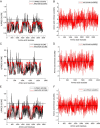Intrinsically disordered proteins of viruses: Involvement in the mechanism of cell regulation and pathogenesis
- PMID: 32828463
- PMCID: PMC7129803
- DOI: 10.1016/bs.pmbts.2020.03.001
Intrinsically disordered proteins of viruses: Involvement in the mechanism of cell regulation and pathogenesis
Abstract
Intrinsically disordered proteins (IDPs) possess the property of inherent flexibility and can be distinguished from other proteins in terms of lack of any fixed structure. Such dynamic behavior of IDPs earned the name "Dancing Proteins." The exploration of these dancing proteins in viruses has just started and crucial details such as correlation of rapid evolution, high rate of mutation and accumulation of disordered contents in viral proteome at least understood partially. In order to gain a complete understanding of this correlation, there is a need to decipher the complexity of viral mediated cell hijacking and pathogenesis in the host organism. Further there is necessity to identify the specific patterns within viral and host IDPs such as aggregation; Molecular recognition features (MoRFs) and their association to virulence, host range and rate of evolution of viruses in order to tackle the viral-mediated diseases. The current book chapter summarizes the aforementioned details and suggests the novel opportunities for further research of IDPs senses in viruses.
Keywords: Aggregation; Cell hijacking; Dancing proteins; IDPs; MoRFs; Viruses.
© 2020 Elsevier Inc. All rights reserved.
Conflict of interest statement
Conflict of interest The authors declare no conflict of interest.
Figures






References
-
- Tompa P. Chapman & Hall/CRC Press; 2010. Structure and Function of Intrinsically Disordered Proteins.
-
- Schweers O., Schönbrunn-Hanebeck E., Marx A., Mandelkow E. Structural studies of tau protein and Alzheimer paired helical filaments show no evidence for β-structure. J Biol Chem. 1994;269:24290–24297. - PubMed
Publication types
MeSH terms
Substances
LinkOut - more resources
Full Text Sources

